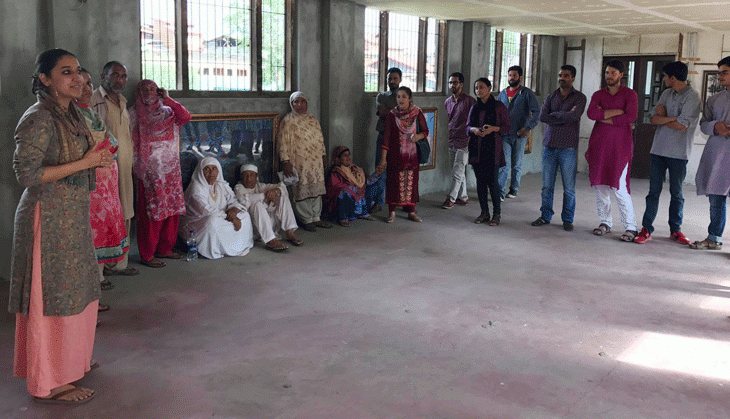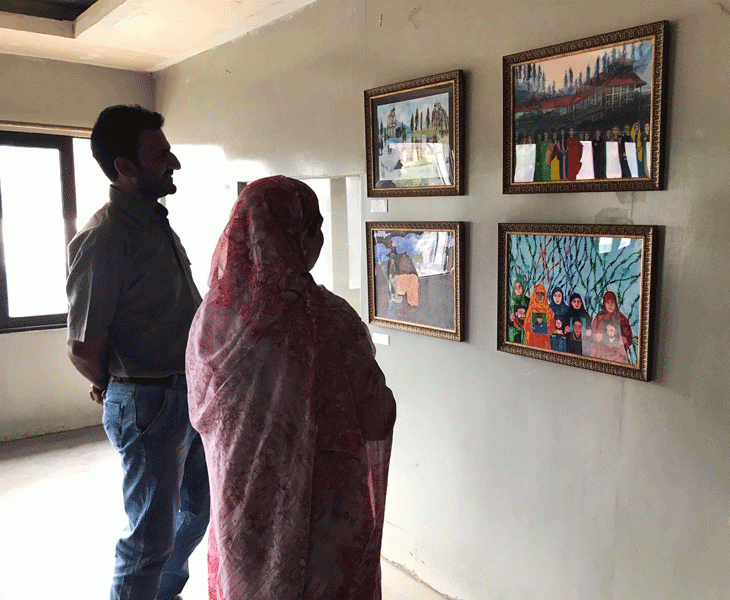An exhibition in Srinagar narrates the bloody history of Kashmir through brushstrokes

In his revolutionary poem ‘Bol’ (Speak Up), Faiz Ahmed Faiz emphasised the need to speak up against all kinds of injustices.
“Speak for your lips are free;
Speak, your tongue is still yours,
Your upright body is yours —
Speak, your life is still yours…”
It so seems that Faiz’s immortal words have inspired Avni Sethi and Rollie Mukherjee, two women from Ahmedabad and Vadodara in Gujarat respectively, to narrate the many shades of Kashmir’s story.
Between 4 and 10 September, the two organised a painting exhibition in the heart of Srinagar’s downtown area with the aim to generate conversations on Kashmir’s burning issues like enforced custodial disappearances, torture and extra-judicial killings.
Avni and Rollie arrived in Kashmir soon after Eid-ul-Zuha holidays to narrate Kashmir’s story through art and practice.
Dialogue through art

Avni is a well-known dancer and heads Conflictorium, an organisation which generates conversations and addresses the theme of conflict by reclaiming intellectual spaces for dialogue through art.
Rollie is an acclaimed artist who uses landscapes in her artworks as a camouflage, depicting death and disappearances.
But what brings the two to Kashmir?
Rollie, who is originally from Jabalpur in Madhya Pradesh but currently based in Vadodara, came to the Kashmir Valley to showcase her first solo painting exhibition titled ‘To Stories Rumoured in Branches’ while using the platform of Ahmedabad-based Conflictorium in association with Srinagar-based Association of Parents of Disappeared Persons (APDP).
“Conflictorium endeavours to generate meaningful conversations through art and practice,” Avni tells Catch, in an exclusive chat in Srinagar.
More than 60 paintings by Rollie were at display at the exhibition held at the Indo-Kashmir Complex in Srinagar’s Nawabazar, a hot bed of armed militancy in the early 1990s.
Most of Rollie’s paintings draw attention to the pain of Kashmir’s half-widows and half-mothers. According to the APDP, “more than 8,000 persons have been subjected to enforced or involuntary disappearances in Jammu and Kashmir over the past three decades”.
Collective pain
But what compelled artist Rollie to use her strokes of genius to share and highlight some of Kashmir’s pain?
She says her memories, based on interactions with Kashmiri shawl and carpet sellers in the early 1990s in Jabalpur, have remained with her.
“Many Kashmiri businessmen would talk about Kashmir and their collective pain. They would talk about the state repression, stories of torture, custodial disappearances and also problems of unemployment etcetera,” Rollie tells Catch.
As the artist grew up and read more and more about Kashmir, her understanding of the conflict, its nuances and complexities, improved manifold.
“Above all, it was through my interactions with common Kashmiri boys and girls, men and women, journalists, lawyers, students, artists and professionals etc on social media that helped me in understanding Kashmir more than the books or hollow television debates ever could,” she says.
As an artist, she says, one has to know and understand people and their pain to put it on canvas.
“You have to empathise with people’s pain and anguish of Kashmir’s half-widows and half-mothers. They are still waiting for their loved ones, hoping against hope.” she says.
An emotional outpouring

In one of her 63 paintings put on display, Rollie shows a group of Kashmiri women displaying pictures of their disappeared loved ones with barbed wire painted in different colours in the backdrop.
“In the absence of their husbands and sons, these people are still expressing hope and you can see their tears are wire cutters. Concertina wire in the background depicts control, siege and surveillance, but you also see its coils breaking because of the tears,” she explains.
“Kashmir’s pellet victims gave me many a sleepless night. I needed a release. Art was my way of releasing my emotion. I needed an alternative space,” she adds.
Rollie says she has been accused of being “anti-national” by her countrymen in Gujarat and elsewhere and that she many a time fears that her studio may come under the attack of “extremists”.
“I have cried for all sufferers from Gaza to Kashmir. I shed tears for Afzal Guru inside my art studio on learning about his hanging. You don’t need to be a Muslim to understand pain of a Muslim or a Hindu to understand pain of a Hindu,” she says.
A shroud of silence
Before arriving in Kashmir, Conflictorium exhibited Rollie’s paintings in cities like Ahmedabad (Gujarat) and Kolkata (West Bengal), too.
In Kolkata, according to Rollie, people were a little more aware about Kashmir conflict and people’s pain than in Gujarat. “In Gujarat, it is difficult to have a conversation on Kashmir.”
“To me, it was, and it still remains a priority to show the work in India. This much I owe to Kashmir,” Avni says.
In Gujarat, she says, not many want to talk about Kashmir.
"The thing about identity is that in order for oneself to exist, one needs an ‘other’. A Kashmiri is that ‘other’ for most people in Gujarat,” she says.
“As Indian subjects, we are also victims of the Indian state. The Indian state is brutal on every identity that is not male, Brahmin and rich. It is brutal on Muslims, Dalits and the marginalised ‘other’”, she says.
Addressing a group of visitors, Avni emphasises that “there are many people in India who do understand and share your pain.”
Softening the edge
“In hosting ‘to stories rumoured in branches’ by Rollie Mukherjee, an important exhibition not only within the landscapes of art practices but within the frameworks of political outreach as much, I believe that the Conflictorium is facilitating an understanding and dialogue that underlines our essential humanism in spite of differences, and softens the edge of blind hatred and anger that this might provoke in the absence of such bridges,” she concludes.
Despite the Eid holidays and a wedding season in September, Rollie’s solo show generated a decent response. Visitors, including many women and girls, kept thronging the place. Some families also dropped by.
Rafique Banday, a Kashmiri entrepreneur, visited the exhibition with his wife and two kids. He also purchased one of Rollie’s paintings.
“It is my second visit to the exhibition. It is very touching. There are some wonderful paintings,” Banday tells Catch.
Conflictorium, she hopes, will soon return to Kashmir to display Rollie’s work again.
"The footfall was satisfactory though we had hoped more purchases would happen,” Avni says.






![BJP's Kapil Mishra recreates Shankar Mahadevan’s ‘Breathless’ song to highlight Delhi pollution [WATCH] BJP's Kapil Mishra recreates Shankar Mahadevan’s ‘Breathless’ song to highlight Delhi pollution [WATCH]](https://images.catchnews.com/upload/2022/11/03/kapil-mishra_240884_300x172.png)

![Anupam Kher shares pictures of his toned body on 67th birthday [MUST SEE] Anupam Kher shares pictures of his toned body on 67th birthday [MUST SEE]](https://images.catchnews.com/upload/2022/03/07/Anupam_kher_231145_300x172.jpg)






